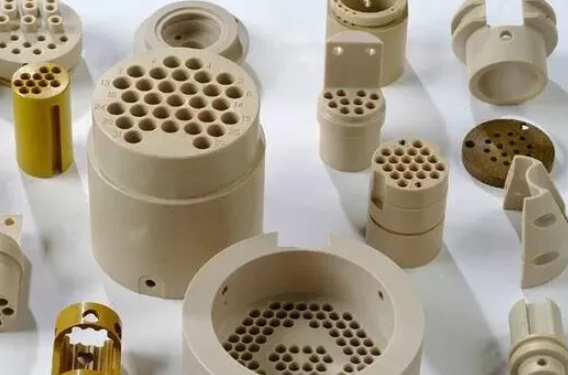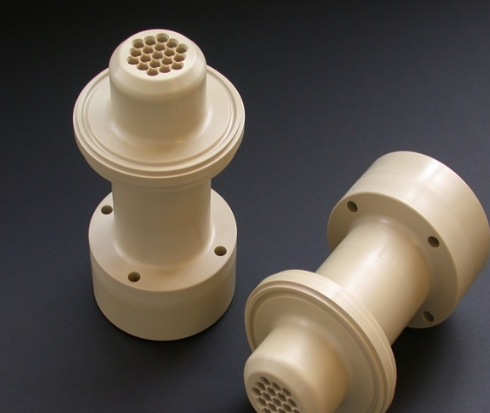The optimal pressure for PEEK injection molding typically ranges from 70 to 150 Megapascals, depending on material characteristics and mold design.
Fundamentals of PEEK Injection Molding
Understanding PEEK Material Properties
PEEK (Polyether ether ketone) is a high-performance engineering thermoplastic. It’s renowned for its excellent mechanical and chemical resistance properties. PEEK operates efficiently at temperatures up to 250°C and maintains its properties under high load and high-temperature conditions. Its specific strength is 90-100 MPa/(g/cm³), making it ideal for demanding applications. PEEK’s cost is relatively high due to its advanced properties, often ranging from $65 to $100 per kilogram. This cost is justified by its longevity and reliability, making PEEK a valuable material in aerospace, automotive, and medical industries.

- Advantages: High thermal stability, exceptional chemical resistance, excellent wear properties.
- Disadvantages: High cost compared to other plastics.
Overview of Injection Molding Process
Injection molding of PEEK requires precise control due to its high-performance nature. The optimal processing temperature ranges from 360°C to 400°C, significantly higher than most plastics. The molding machines should have a high injection pressure capability, typically around 70 to 150 MPa, to accommodate PEEK’s high viscosity. The cycle time for PEEK can be longer, averaging between 30 to 60 seconds, due to its high melting point and cooling requirements.
- Machinery Costs: The specialized machinery needed for PEEK injection molding can be costly, ranging from $30,000 to $150,000, depending on the size and specifications.
- Energy Efficiency: PEEK molding consumes more energy due to high-temperature requirements, impacting overall production costs.
Bolded Key Points:
- PEEK’s high performance comes with a higher cost but offers unparalleled quality and reliability.
- Precise temperature control is crucial in PEEK injection molding, affecting the machine selection and operating costs.
Determining Injection Pressure for PEEK
Factors Influencing Injection Pressure
Material Viscosity: PEEK’s high viscosity requires higher injection pressures compared to other plastics. The viscosity can be around 10,000 Pa.s at processing temperatures.
Machine Specifications: Machines capable of delivering pressures from 70 to 150 MPa are required for PEEK. The power consumption of these machines is higher, directly impacting operational costs.
Mold Design: Complex mold designs with intricate geometries or thin walls demand higher pressures. This can increase the cost of mold manufacturing.
Bold Key Point:
- The high viscosity of PEEK necessitates the use of specialized machinery capable of exerting higher pressure, thus increasing the overall production cost.
Calculating Optimal Pressure for PEEK
To calculate the optimal pressure for PEEK injection molding, consider the following:
- Material Characteristics: Incorporate PEEK’s melting point (343°C) and glass transition temperature (143°C) into calculations.
- Mold Design Parameters: Account for mold size, gate location, and wall thickness. Thinner walls require higher pressure.
- Machine Capabilities: Consider the maximum pressure your machine can exert. Ensure it aligns with PEEK’s requirements.
PEEK Molding Equipment and Setup
Essential Equipment for PEEK Molding
PEEK molding requires specific equipment due to its high-performance characteristics. The essential equipment includes:
- High-Pressure Injection Molding Machine: Capable of delivering pressure between 70 to 150 MPa. These machines typically cost between $30,000 to $150,000 depending on their specifications.
- Temperature Control Units: Needed for precise temperature control up to 400°C. Costs can range from $5,000 to $20,000.
- Mold Temperature Controller: Essential for maintaining consistent mold temperatures, critical for PEEK’s quality. Prices vary from $3,000 to $10,000.
- Drying Equipment: PEEK must be dried before processing to remove moisture. Industrial dryers cost around $2,000 to $5,000.
Bold Key Point:
- Investing in specialized equipment is crucial for PEEK molding, directly impacting the initial setup cost and operational efficiency.
Setting Up the Injection Molding Machine
Proper setup of the injection molding machine is vital for the successful molding of PEEK. Key steps include:
- Temperature Settings: Set the barrel temperature between 360°C to 400°C and mold temperature around 140°C to 160°C.
- Pressure Adjustments: Start with a pressure setting of 100 MPa and adjust based on the specific mold and part design.
- Cycle Time: Establish a longer cycle time, usually 30 to 60 seconds, due to PEEK’s high melting point.
Challenges and Solutions in PEEK Molding
Common Issues in PEEK Injection Molding
PEEK injection molding, while producing high-quality components, faces several challenges:
- High Material Costs: PEEK costs between $65 to $100 per kilogram, significantly higher than other thermoplastics.
- Stringent Temperature Requirements: Precise temperature control is necessary, with processing temperatures around 360°C to 400°C.
- Warpage and Distortion: Due to PEEK’s high melting point and cooling rate, parts are susceptible to warpage.
Bold Key Point:
- The high cost of PEEK material and the need for precise temperature control present significant challenges in the molding process, impacting both production efficiency and cost.
Strategies for Managing Pressure-Related Problems
Effectively managing pressure-related issues in PEEK molding requires strategic approaches:
- Optimized Mold Design: Design molds to accommodate high pressure and reduce stress concentration. This involves considering gate size, runner system, and venting.
- Pressure Monitoring Systems: Implement advanced pressure monitoring systems to maintain optimal pressure levels and detect any irregularities.
- Regular Maintenance: Routine checks and maintenance of the injection molding machine ensure consistent pressure application.

Quality Control in PEEK Injection Molding
Monitoring Pressure and Quality
Quality control in PEEK injection molding is crucial to ensure the integrity and performance of the final product. Key aspects include:
Real-time Pressure Monitoring: Utilize sensors to monitor and maintain the required pressure range of 70 to 150 MPa. This helps in identifying any deviations that can affect the product quality.
Visual and Dimensional Inspection: Implement a systematic approach for inspecting the dimensions and surface quality of each molded part.
Material Quality Checks: Regular testing of PEEK material properties such as viscosity and melting point, ensuring consistency in material quality.
Bold Key Point:
Continuous monitoring of pressure and regular inspections are essential for maintaining high quality in PEEK injection molding, directly impacting the reliability and performance of the products.
Ensuring Consistency in Production
Maintaining consistency in PEEK molding involves several key strategies:
Standardized Process Parameters: Establish and adhere to standardized settings for temperature, pressure, and cycle time.
Regular Machine Calibration: Calibrate machines periodically to ensure that they operate within specified parameters, aiding in consistent quality production.
Employee Training: Ensure that operators are well-trained in handling the specific requirements of PEEK molding.




